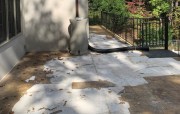Wouldn’t you think that after all these years we would know all there is to know about concrete slabs? And yet there are still plenty of examples of slabs failing to perform as expected and intended. Just taking a look at the minutes from recent meetings of ACI Committee 302, Construction of Concrete Floors, you can see that even the nation’s top experts sometimes remain unsure of certain aspects of slab construction. For example:
- What’s the ideal concrete floor for subsequent polishing?
- Do liquid silicates act as curing agents?
- What is the impact of manufactured sand in a slab mix?
- What causes early slab efflorescence? The water? Admixtures?
- Does a concrete slab directly on a vapor retarder curl more than one on an aggregate base?
- Is it acceptable to use a roller bug on a slab surface to reduce aggregate shadowing?
- What is the best way to mitigate the problem of dominant joints?
- How deep should the cut be with an early-entry saw?
- What is a reasonable thickness tolerance for a floor?
- What is the best way to measure entrained air content and when/where should it be measured?
- Is there anyone who can answer all these questions??
This give me some ideas for topics at the next World of Concrete luncheon on Quality in Concrete Slabs, but we can’t cover it all. What do you think we should discuss at the next WOC luncheon? Click here to respond to me directly!



